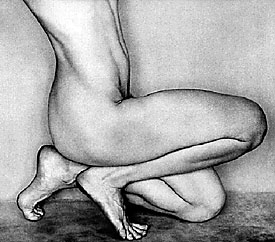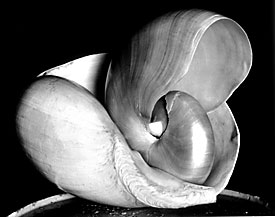 |
|
Photo courtesy of the Center for Creative Photography
|
Edward Weston, "Nude," 1927.
|
|
|
By Blair Lazarus
Arizona Daily Wildcat
Thursday August 28, 2003
Exhibit highlights the woman behind the man behind the lens
Edward Weston was undeniably one of the most important photographers of the 20th century. But perhaps no one was more crucial in the development of his style than his lover, collaborator and fellow photographer Margrethe Mather.
Weston had relationships with other celebrities of the art world as well; his friendships with Diego Rivera and Frida Kahlo were documented in a collection of journal entries and photographs entitled "Mexico." In fact, portraits Weston took of Kahlo became part of the visual inspiration for the film "Frida."
But none of these celebrity connections could have existed without Margrethe Mather.
The exhibit, "Margrethe Mather and Edward Weston: A Passionate Collaboration" is the first exhibition of Mather's work.
Although it was not uncommon for Weston to become involved with the women he worked with (he left Mather to move to Mexico with another female artist), Mather had the most impact with regard to Weston's style.
 |
|
Photo courtesy of The Center for Creative Photography
|
Edward Weston, "Shells," 1927.
|
|
|
While Weston was very much middle class, Mather was more bohemian, which broadened Weston's work and compelled him to travel for his work.
Walking around the exhibit, one can see the evolution of Weston's style from a romantic view ÷ called pictorial ÷ to the sharper focus that is the backbone of modern photography. In his very early work, Weston, like most other artists of his day, favored soft focus shots that created illusion rather than revealing reality.
By the end of their collaboration, Mather and Weston were capturing sharp focus scenes that helped usher in the modernist style of photography.
Some great examples of these are the Center's groupings of Weston's themed works, like those of vegetables and his early nudes.
The curator for "A Passionate Collaboration" is Beth Gates Warren, who worked in conjunction with the Santa Barbara Museum of Art.
Warren said she drew upon public and private sources for inclusion in the exhibit and, because of the nature of the show, had to do quite a bit of detective work as well.
There are 20 pictures from the CCP on loan for the exhibit, which has been traveling for several years.
"A Vision Conserved," which is running concurrent with "A Passionate Collaboration," shows the important work that goes into preserving and maintaining the Weston archives, which include 2,000 prints and 10,000 negatives, as well as family scrapbooks and Weston's journals.
Dianne Nilsen, rights and reproductions coordinator for the CCP and co-curator of "A Vision Conserved," said, "(A Vision Conserved) shows a behind-the-scenes look into what goes on at the CCP."
Sculptor William Edmondson illustrates one example of the importance of preservation.
Edmondson was the first black artist to have a show at the Metropolitan Museum of Art in New York City.
And because the house in which he worked was bulldozed in 1950, the only record of his studio lies in a negative from the Weston archive.
The exhibit features examples of different methods of preservation, including traditional methods as well as more modern ones.
With the advent of the digital age, archivists can scan negatives so they don't have to handle them as often, which is a form of preservation in and of itself.
The Weston archive is also unique and especially meaningful to photographers as well as all artists because it is so complete.
It is part of the CCP's "core collection" of archives, and was acquired in 1981 from Weston's sons.
Nilsen said that such a collection, while perhaps one of the CCP's biggest, really just demonstrates the prominence of the Center in the photography world.
"The (CCP) has a history of getting really important works," she said.
The CCP will be hosting several upcoming events in conjunction with the exhibitions.
The first of these is a reception Aug. 29 at 5 p.m., which will include a lecture by Warren. The reception is free, as are all upcoming gallery discussions.
Both exhibits will run until October 12 and are located in the Center for Creative Photography building. Gallery hours are 9 a.m. to 5 p.m. Monday through Friday and 12 p.m. to 5 p.m. Saturday and Sunday.
The Center for Creative Photography arrived on campus in 1975 with five archives, which today has swelled to more than 60, including, most notably, the archives of Ansel Adams.
